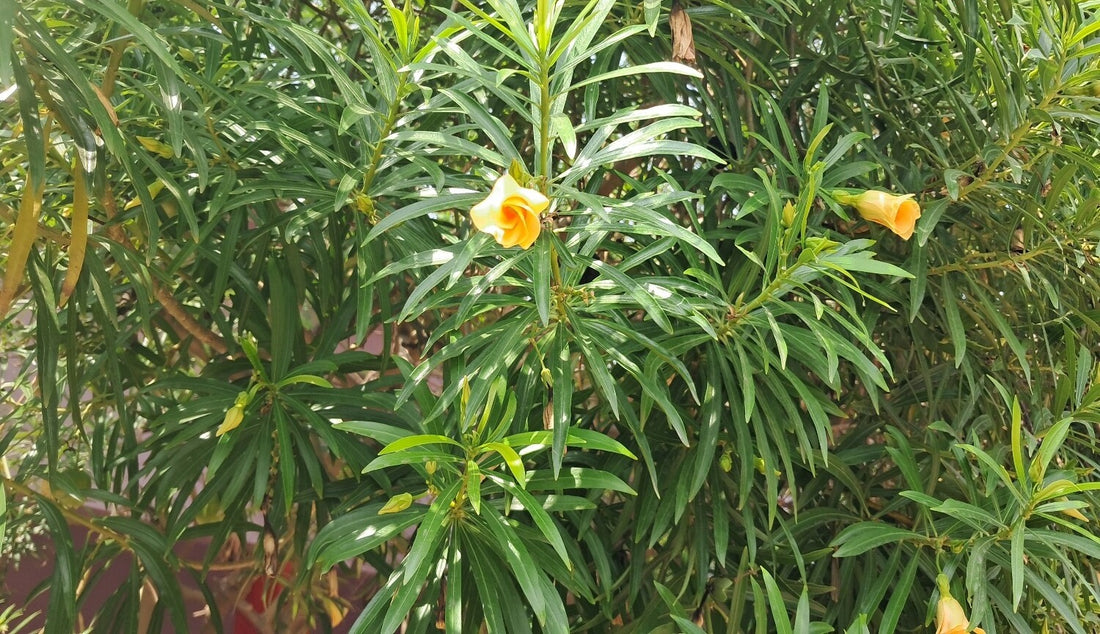

The Kaner tree, known for its stunning flowers and versatility, is an essential part of arid and semi-arid ecosystems. This tree not only beautifies landscapes but also offers medicinal and ecological benefits to communities across the regions it gro Read more
Trending
Trees for Corporates
The Kaner Tree: A Fusion of Beauty and Utility in Nature
The Kaner tree, known for its stunning flowers and versatility, is an essential part of arid and semi-arid ecosystems. This tree not only beautifies landscapes but also offers medicinal and ecological benefits to communities across the regions it grows in.
Botanical Marvel: The Kaner tree, scientifically known as Nerium oleander, is widely recognized by other names across different regions. It is referred to as "Oleander" in English, "Rakta Kaner" or "Karavira" in Sanskrit, and "Kanagilu" in Kannada. This evergreen shrub can grow up to 20 feet in height, bearing clusters of beautiful pink, white, or red flowers. Despite its beauty, all parts of the Kaner tree are toxic, which adds an intriguing aspect to its overall character in nature.
Cultural Symbolism: The Kaner tree holds cultural significance in many regions due to its striking appearance and its role in traditional medicine. In some cultures, it symbolizes strength and endurance because of its ability to thrive in harsh environments. It is also planted in gardens and public spaces as an ornamental tree, valued for its continuous flowering throughout the year.
Ecological Importance: Despite its toxicity, the Kaner tree plays a vital role in its ecosystem. It is drought-resistant and thrives in poor soils, making it an ideal plant for erosion control in arid areas. Its thick foliage provides shelter for various insects and birds, while the tree itself helps maintain soil structure in dry regions.
Versatile Uses: The Kaner tree has a variety of uses, particularly in traditional medicine. Its extracts are used to treat skin disorders, heart conditions, and other ailments in folk medicine, though great caution is required due to its toxicity. It is also frequently planted as a windbreak or hedge, and its hard, durable wood is used for small construction purposes.
Economic Importance: The Kaner tree contributes to local economies through its use in landscaping, particularly in urban and desert regions where its hardiness is valued. Its medicinal properties also provide an income source for those involved in the preparation of traditional herbal remedies, though careful handling is crucial.
Traditional Knowledge: Indigenous communities have long held knowledge of the Kaner tree's potential, carefully balancing its toxic nature with its medicinal uses. Traditional healers have developed methods to safely use parts of the tree to treat various health conditions, passing this knowledge through generations.
Environmental Sustainability: The Kaner tree plays an important role in sustainable landscaping, particularly in water-scarce regions. Its ability to withstand drought makes it an ideal choice for xeriscaping, reducing the need for irrigation. This contributes to water conservation efforts, making it an environmentally friendly choice for green spaces in arid climates.
Challenges and Conservation: Although the Kaner tree is widely planted, its toxic nature poses challenges for livestock and pets that may inadvertently ingest its leaves or flowers. Promoting awareness of its dangers while advocating for its controlled use in landscaping is essential to ensuring that this beautiful but potentially hazardous tree is planted responsibly.
Community Empowerment: Local communities can benefit economically from the Kaner tree through its use in traditional medicine and landscaping. Training programs that focus on the safe handling and use of Kaner products can empower communities to harness its benefits while minimizing risks.
Climate Adaptation: The Kaner tree's resilience to harsh climates makes it a valuable ally in combating the effects of climate change. Its ability to thrive in hot, dry conditions and its low water requirements make it an ideal species for planting in areas affected by desertification, contributing to the restoration of degraded landscapes.
Consumer Awareness: Raising awareness about the Kaner tree’s medicinal potential and dangers is crucial for responsible use. Educating consumers about its toxic nature, while promoting its use in safe, controlled environments such as urban landscaping, can help reduce risks while maximizing its benefits.
Global Collaboration: Addressing the challenges and opportunities presented by the Kaner tree requires collaboration between local governments, environmental groups, and communities. International efforts focused on arid land conservation, sustainable landscaping, and public health can help preserve the Kaner tree’s place in urban and rural ecosystems.
Conclusion: The Kaner tree stands as a testament to nature’s beauty and resilience. Its vibrant flowers, medicinal uses, and adaptability to harsh environments make it a valuable resource for both ecosystems and communities. By promoting sustainable practices and raising awareness about its benefits and risks, we can ensure that the Kaner tree continues to flourish for future generations.
You may also like
Corporate Plantations
Most Popular
Connect with us
-
👥 Corporates
If you are looking for:
- 🌲 Tree Plantation Events
- 📊 CSR Projects
📧 corporate@growbilliontrees.com
📞 +91 9699723523
💬 +91 9325931304 WhatsApp (Only)
🕒 Mon - Sat | 10am - 7pm IST
-
🧩 Tree Plantation NGOs
If you are looking for:
- 💰 Financial Assistance
- 🤝 Operational Support
📧 support@growbilliontrees.com
📞 +91 9699723523
💬 +91 9325931304 WhatsApp (Only)
🕒 Mon - Sat | 10am - 7pm IST
-
🌼 Individuals
If you are looking for:
- 👥 Group Tree Plantation Drive
- 🌳 Bulk Tree Plantation
📞 +91 9699723523
💬 +91 9325931304 WhatsApp (Only)
🕒 Mon - Sat | 10am - 7pm IST





















